The Rule of Law Complex
A few days ago I came across an AP news piece with a headline that read some 30 Iraqi judges have been killed in Iraq, underscoring need for tight security. The solution, we read, is a “new heavily secured justice complex in eastern Baghdad” better known as The Rule of Law Complex “that began operating last month” and is further described as a “mini-Green Zone” for judges, investigators and their families who are trying to avoid being the target of violence.
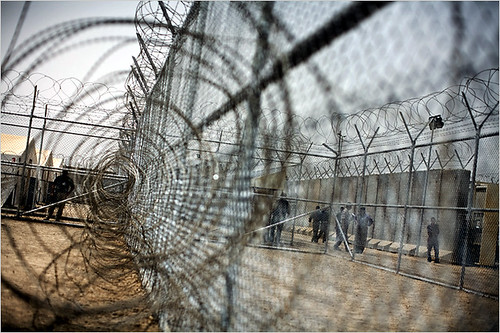
[Image: The Rule of Law Complex in Baghdad, photo by Benjamin Lowy for The New York Times.]
But, if the new U.S. Embassy Compound (or, “Fortress Baghdad” as it’s been called) and the massive urban squat that is the real Green Zone hunkered in the heart of Iraq’s capital city isn’t symbolic enough already of how the super-imposition of democracy and a “rule of law” is failing in the region, then should this new justice compound in the neighborhood of Rusafa really give us any confidence?
I mean, how can we not be skeptical of any measure of justice in Iraq right now? The fact that it declares itself the “The Rule of Law Complex” makes me even more curious about the ironic mechanisms of justice that are being practiced there. How is it being administered, from what political vantage?
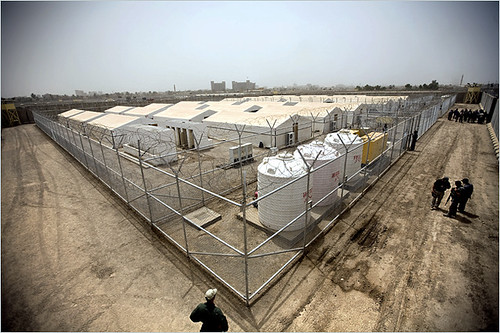
[Image: The Rule of Law Complex in Baghdad, photo by Benjamin Lowy for The New York Times.]
Looking at the place we are reminded of how prototypical it appears of the kinds of militarized installations that have emerged from the war on terror. Who wouldn't easily mistake this place for Guantánamo Bay, or even one of those tented immigration facilities along the border in Arizona or Texas? Could Giorgio Agamben have been any more accurate when he said the camp has become the definitive spatialization of contemporary politics today?
Given the rampant sprawl of global squatter settlements, refugee communities, homeless encampments, illegal immigration detention facilities, and various other nomadic urbanisms associated with the hyper flows of mass migration, it would appear the world’s counter to rapid urbanization is one of informal and reciprocal campification.
I found a great reading of the above photo by John Lucaites, a professor of rhetoric, culture and American studies at Indiana University, who posted this to his website No Caption Needed (forgive the massive quote here):
More recently the New York Times (referred to in the above excerpt) ran a good story describing this new legal enclave set up to propel the process of trying Iraqi criminals, which at the time the story was run housed 12 Iraqi judges and 4 police investigators with their families, while also storing close to 5,000 detainees (15 to a cell) – that is already double its intended capacity due to increased apprehensions from the surge. The article also tells us how most rulings are based on confessions alone usually with little evidence, while the administration itself is even racked by internal sectarian riffs amongst investigators and judges. Nevertheless, skepticism of actual justice seems to run all the way through this legal enclave.
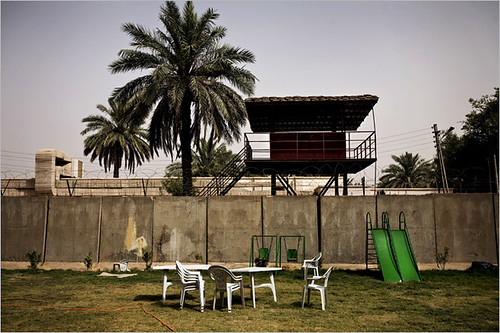
[Image: The Rule of Law Complex in Baghdad, photo by Benjamin Lowy for The New York Times.]
However, from my measly perspective here, beginning to truly understand how politics and space are inseparably linked and together embody both spaces of actual built environment as well as political agency, what do installations like this one suggest about the political architecture at work in Iraq? How can we gage the efficacy or ethical value of the juridical logic that is building upon itself and whose aim is ostensibly to unite Iraq when looking at such structures? If these sites are any indication of the governing logic what is the nature of justice the American project is trying to hatch in the Middle East?
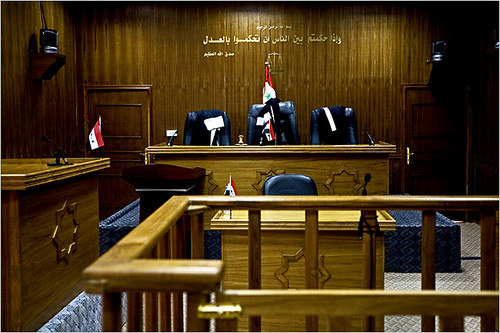
[Image: The Rule of Law Complex in Baghdad, photo by Benjamin Lowy for The New York Times.]
While I certainly don't pretend to have any resolutions, for the purposes of this blog I am merely interested in the ways structure, architecture, and spatial practice can provide a prismatic glimpse into the political logic of those authoritarian forces that produce such spaces. So far, in this scenario it looks like “justice” can only be delivered from behind the blast proof walls of a kind of futuristic retro-medieval fortress that is constantly under attack, ultimately out of place and suspended in a sea of political violence for which itself seems to instigate. Or, “justice” is met through these other types of swift and hidden canopies that are guarded by buffers of razor wire fencing and armed guards where the judges themselves are the ones in the crosshairs. Either way, the overarching logic seems desperate at best.
This Rule of Law Complex, according to the piece in the New York Times, is part of an effort to establish “a network of legal complexes” through out Iraq – a kind of hidden archipelago of judicial enclaves. There is currently a new complex being built in the capital of Anbar Province in Ramadi, a new Central Criminal Court in Baghdad which “is expected to conduct about 5,000 trials this year”, and a new courthouse compound is being built in Rustafa in addition to the Rule of Law Complex which will remain in use funded by $49 million dollars in American support.
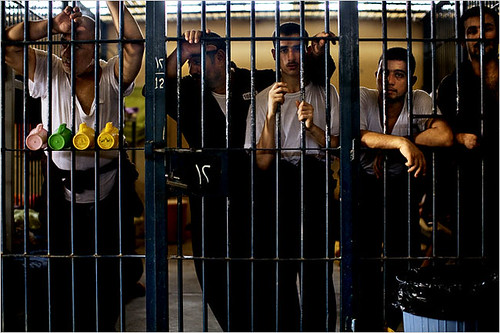
[Image: The Rule of Law Complex in Baghdad, photo by Benjamin Lowy for The New York Times.]
I honestly don’t know what to make of this place. On one hand I try to see it as a legitimate attempt for the Iraqi government itself to bring justice to one of the most tragic places on earth. But, in my own cynical distortions I can’t help to imagine a future global landscape slowly becoming more and more populated by this roving network of militarized tent cities, rounding up thousands of assorted “terrorist suspects” every day – linking them through some minimally publicized court system within a larger fragmented geography of “mini-Green Zones” and armored ‘Rule of Law Complexes’ perpetually on the prowl. Prodded by a so-called 'Long War (On Terror)' they become increasingly autonomous and less tethered over time, meandering in complete disregard for national and political boundaries, stealthily ballooning on strategic hilltops, in secret valleys, catching, detaining and sentencing terrorists over night. Altogether, expanding this greater amorphous Green Zone of spatial exception that creeps along in a spotty connection of spawned fortresses, temporary courtrooms, and nomadic detention sites, fanning out towards an elusive geopolitical border.
Also:
carceral urbanism: CMU and the Arab round up
A Mini-city for Trying Terror
Guantánamo and the Border Exodus

[Image: The Rule of Law Complex in Baghdad, photo by Benjamin Lowy for The New York Times.]
But, if the new U.S. Embassy Compound (or, “Fortress Baghdad” as it’s been called) and the massive urban squat that is the real Green Zone hunkered in the heart of Iraq’s capital city isn’t symbolic enough already of how the super-imposition of democracy and a “rule of law” is failing in the region, then should this new justice compound in the neighborhood of Rusafa really give us any confidence?
I mean, how can we not be skeptical of any measure of justice in Iraq right now? The fact that it declares itself the “The Rule of Law Complex” makes me even more curious about the ironic mechanisms of justice that are being practiced there. How is it being administered, from what political vantage?

[Image: The Rule of Law Complex in Baghdad, photo by Benjamin Lowy for The New York Times.]
Looking at the place we are reminded of how prototypical it appears of the kinds of militarized installations that have emerged from the war on terror. Who wouldn't easily mistake this place for Guantánamo Bay, or even one of those tented immigration facilities along the border in Arizona or Texas? Could Giorgio Agamben have been any more accurate when he said the camp has become the definitive spatialization of contemporary politics today?
Given the rampant sprawl of global squatter settlements, refugee communities, homeless encampments, illegal immigration detention facilities, and various other nomadic urbanisms associated with the hyper flows of mass migration, it would appear the world’s counter to rapid urbanization is one of informal and reciprocal campification.
I found a great reading of the above photo by John Lucaites, a professor of rhetoric, culture and American studies at Indiana University, who posted this to his website No Caption Needed (forgive the massive quote here):
The real question posed by the photograph is who is doing the watching? And what are they seeing—what exactly does the rule of law look like? What does it envision? For the rule of law to gain the traction necessary to a functioning constitutional democracy in Iraq, one might imagine that the most important viewers here would be Iraqi citizens, though what exactly they might need to see in order to coach their trust in an imperial and imposed legal system is not easy to know from our ethnocentric, Judeo-Christian, judicial world view. But this photograph seems to tell a different story, with a different purpose in mind. The viewer is decidedly western, not Iraqi, and the goal has less to do with creating identification with the rule of law than with reinforcing western attitudes concerning the uncivilized and threatening conditions of a world “plagued by suicide bombers and renegade militias.” Note, for example, that the camera is positioned along a west-to-east axis, with Central Baghdad sitting to the west of the complex (a point emphasized by the NYT reporter). The viewer is thus literally situated to see from a western perspective. But more, the viewer is framed figuratively by a modernist aesthetic that incorporates many of the conventions that anthropologist James C. Scott affiliates with “seeing like a state.” The image is shot from a high angle and at some distance from the event, thus encouraging the perspective of a neutral spectator who can neither be harmed by nor affect the action unfolding below. Such distancing separates the viewer from the scene both physically and emotionally, substituting a topographical perspective that encourages the rational and strategic calculation of actions and events, rather than an emotional identification with either. The appeal to a strict, instrumental rationality is further invoked by the functionalist and stark geometrical design of the complex, underscored by the trajectory and perspective of the fence as it draws our line of sight to the distant and barely visible Baghdad.
The photograph thus locates the “rule of law” within a western perspective for modern eyes. One might even imagine the nineteenth-century American frontier with military forts used to protect “settlers” from the threat of indigenous forces in the “march of the flag” ever westward. The flag now marches in a different direction, but the conclusion seems obvious: Their present is our past! We can only wonder how far the analogy will extend.
More recently the New York Times (referred to in the above excerpt) ran a good story describing this new legal enclave set up to propel the process of trying Iraqi criminals, which at the time the story was run housed 12 Iraqi judges and 4 police investigators with their families, while also storing close to 5,000 detainees (15 to a cell) – that is already double its intended capacity due to increased apprehensions from the surge. The article also tells us how most rulings are based on confessions alone usually with little evidence, while the administration itself is even racked by internal sectarian riffs amongst investigators and judges. Nevertheless, skepticism of actual justice seems to run all the way through this legal enclave.

[Image: The Rule of Law Complex in Baghdad, photo by Benjamin Lowy for The New York Times.]
However, from my measly perspective here, beginning to truly understand how politics and space are inseparably linked and together embody both spaces of actual built environment as well as political agency, what do installations like this one suggest about the political architecture at work in Iraq? How can we gage the efficacy or ethical value of the juridical logic that is building upon itself and whose aim is ostensibly to unite Iraq when looking at such structures? If these sites are any indication of the governing logic what is the nature of justice the American project is trying to hatch in the Middle East?

[Image: The Rule of Law Complex in Baghdad, photo by Benjamin Lowy for The New York Times.]
While I certainly don't pretend to have any resolutions, for the purposes of this blog I am merely interested in the ways structure, architecture, and spatial practice can provide a prismatic glimpse into the political logic of those authoritarian forces that produce such spaces. So far, in this scenario it looks like “justice” can only be delivered from behind the blast proof walls of a kind of futuristic retro-medieval fortress that is constantly under attack, ultimately out of place and suspended in a sea of political violence for which itself seems to instigate. Or, “justice” is met through these other types of swift and hidden canopies that are guarded by buffers of razor wire fencing and armed guards where the judges themselves are the ones in the crosshairs. Either way, the overarching logic seems desperate at best.
This Rule of Law Complex, according to the piece in the New York Times, is part of an effort to establish “a network of legal complexes” through out Iraq – a kind of hidden archipelago of judicial enclaves. There is currently a new complex being built in the capital of Anbar Province in Ramadi, a new Central Criminal Court in Baghdad which “is expected to conduct about 5,000 trials this year”, and a new courthouse compound is being built in Rustafa in addition to the Rule of Law Complex which will remain in use funded by $49 million dollars in American support.

[Image: The Rule of Law Complex in Baghdad, photo by Benjamin Lowy for The New York Times.]
I honestly don’t know what to make of this place. On one hand I try to see it as a legitimate attempt for the Iraqi government itself to bring justice to one of the most tragic places on earth. But, in my own cynical distortions I can’t help to imagine a future global landscape slowly becoming more and more populated by this roving network of militarized tent cities, rounding up thousands of assorted “terrorist suspects” every day – linking them through some minimally publicized court system within a larger fragmented geography of “mini-Green Zones” and armored ‘Rule of Law Complexes’ perpetually on the prowl. Prodded by a so-called 'Long War (On Terror)' they become increasingly autonomous and less tethered over time, meandering in complete disregard for national and political boundaries, stealthily ballooning on strategic hilltops, in secret valleys, catching, detaining and sentencing terrorists over night. Altogether, expanding this greater amorphous Green Zone of spatial exception that creeps along in a spotty connection of spawned fortresses, temporary courtrooms, and nomadic detention sites, fanning out towards an elusive geopolitical border.
Also:
carceral urbanism: CMU and the Arab round up
A Mini-city for Trying Terror
Guantánamo and the Border Exodus







2 Comments:
Justice? But whose justice? Or what is justice?
Ahem... . Your quoted author got it wrong. Western justice is NOT based upon "Judeo"-"Christian" principles; rather, it is based upon Anglo-Saxon principles of common law.
Post a Comment
<< Home